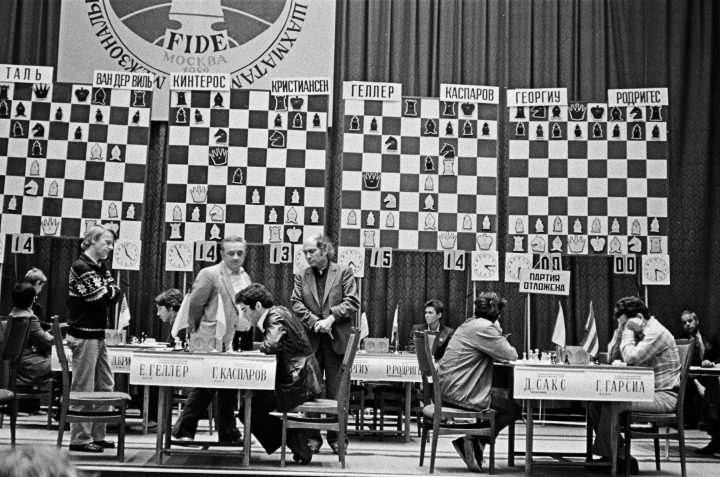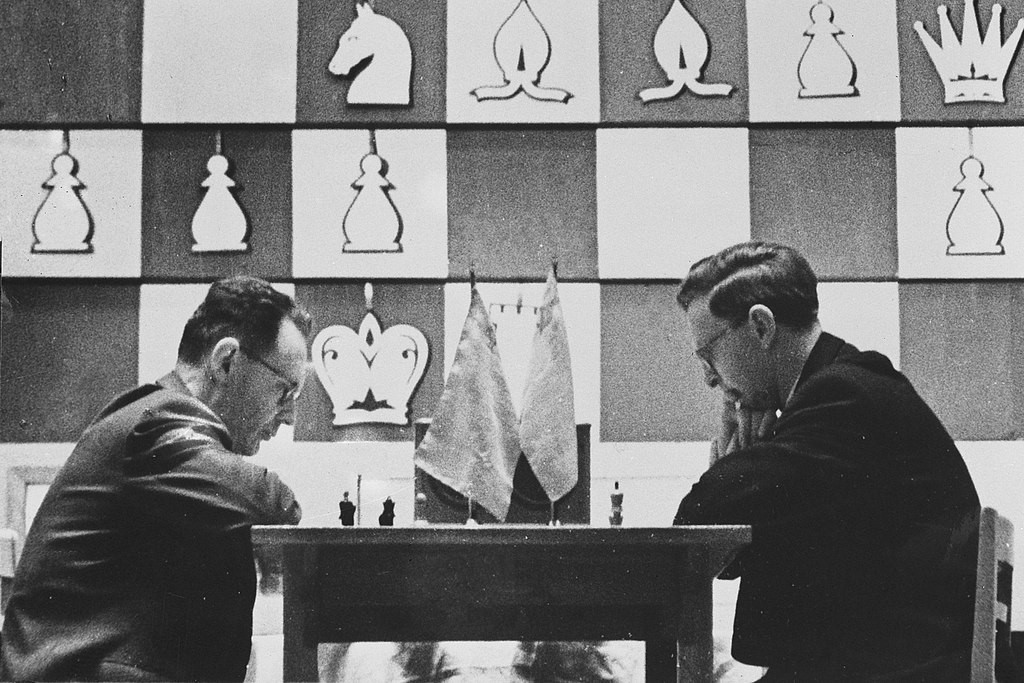


My friend, Max was excited. “See, isn’t that Garry?”
Then he was perplexed. “But this was how he looked 40 years before. What is he doing here now on the cover of ChessBase Magazine?”
“They are running a special on his ascent to the world championship through the Interzonal and the Candidates’ in which he beat Beliavsky, Korchnoi and Smyslov in succession”, I explained.

Moscow Interzonal 1982. Young Garry Kasparov contemplates his next move against Efim Geller. His anxious opponent and Misha Tal wonder what he would play. The game ended in a draw. | Photo: Boris Dolmatovsky, ChessPro
Max was bemused. “Not Smyslov! He would have retired long since after those matches with Botvinnik.”
I said, “Your memory lets you down. Smyslov continued to play after those matches with Botvinnik. Here he is enjoying his second summer playing the Candidates with a player who is half his age.”
Then I added, “Not that he won any game, though. But he put up a gallant fight.”

Botvinnik v Smyslov on April 19, 1957 | Photo: Fotograaf Onbekend / Anefo
There is more to this feature than Garry. The magazine also includes games from two other Interzonals, Las Palmas and Toluca 1982. Overall, you see more than one legendary name here — Tal, Geller, Larsen, Spassky and Petrosian, not to mention younger talents like Jan Timman and Ulf Andersson. The annotated games are a mix of the old and the new.
The focus of the special is of course on Garry with articles on his opening play, middlegame strategy & tactics and the endgame.
That brings us to the present. Even as I write these lines, Nakamura has won the chess.com Speed Championship, beating Maxime Vachier-Lagrave. The Frenchman, to his credit, had eliminated Carlsen in the penultimate round.
What happened to Magnus? Well-wishers of the world champion had a foreboding that he would have a setback sooner or later. He has played chess without respite for the last 9 months or so. So this was to happen. Will he be able to rest and recover his form when he plays in the Wijk Tournament next January? Time will tell.
For now Nakamura still remains the most dangerous rival for Magnus. One only has to look at the games from the Carlsen Chess Tour Final in this issue to understand why.

Magnus Carlsen | Photo: Lennart Ootes / Altibox Norway Chess
While Carlsen eliminated Ding Liren, Nakamura eased out Dubov. Then followed a marathon between Carlsen and Nakamura. As is known, Magnus won this cliffhanger by the narrowest margin. In this issue, Peter Heine Nielsen analyses the last game, the outcome of which could have gone either way.
It is not easy to pick and choose among other hard-fought games, and several have been annotated by Romain Edouard in this issue. I have cross-checked his analysis with my own and that of others, especially Evgeny Gleizerov (“64 Chess Review” September, 2020). I am offering two games here with my own commentary for readers not familiar with current theory and practice.
Here is the first of them:
Note that the games are presented first without annotations — select the second entry from the list to see the annotated version
A fine victory by Magnus! For once Nakamura’s optimism let him down.
Now comes the second:
A dramatic battle in which Nakamura’s counterattack prevailed in the end.
The second part of the database includes all the games from the FIDE Online Olympiad.
Unfortunately, this event was marred by shocking blackouts, dubious decisions and unsavoury controversies. The quality of games also (especially on lower boards) left much to be desired. I do not think this event will occupy a high place in the provenance of Olympiads. However, this is not to overlook the sincerity and hard work of the participants who prepared as well as they could and played in conditions far from normal.
Only the fine performance by some of them saved this event from ignominy and falling into oblivion. Quite a few of these games have been annotated by the players themselves, and they are the best part of the database in this issue. Among them, I would single out the two Vishy Anand v Jan-Krzysztof Duda encounters, both analysed by the Polish talent, and also the Wesley So v Alexander Grischuk game, analysed by the American grandmaster himself.
One player who shone in this event was Alexei Shirov who won the prize for the most brilliant combination.
However, I was drawn to another game in this issue:
Shirov had the gambler’s luck in this game even as his opponent lost his bearings in a position that he should have won.
This brings me to the rest of the magazine. There are as many as 11 opening surveys ranging from the King’s Gambit to the King’s Indian. December is a busy month. If time permits, I would like to deal with them in a separate review. For now, I will single out the surveys on the French, Benko and the Bishop’s Gambit for special mention.
Apart from the openings, this issue has the standard features on tactics, strategy and the endgame.
The main database of the issue has 5759 recent games of which 35 are deeply annotated.
A major contribution is made by Romain Edouard and Roven Vogel, who have annotated 12 and 10 games each. It may be noted that there are more annotated games in the sections on opening theory and training. Well, practice makes perfect.
Recommended.
1) Boris Dolmatovsky, the legendary Russian photographer captured the magic moments from the Moscow Interzonal 1982: Part 1 | Part 2
2) Botvinnik wrote extensively on the three matches he played with Smyslov. His commentary along with that of others may be found in the book Botvinnik-Smyslov, Three World Chess Championship Matches (New in Chess, 2009).
3) History buffs may check out Kasparov’s own account of the Moscow Interzonal and the Candidates’ Matches from the first part of his trilogy, Garry Kasparov on Garry Kasparov (Everyman Chess, 2011).
They can have a more comprehensive view of this world championship cycle from a perusal of the contemporary Chess Life Magazine (years 1982 and 1983). See the digital archive.
Russian readers would benefit from the perusal of the following archives for the years 1982 and 1983.
4) There are a number of fine books on individual Chess Olympiads. Recently a series of new titles have appeared on early Olympiads. Together they offer a perspective on this unique event: http://chess.comrel.pl/